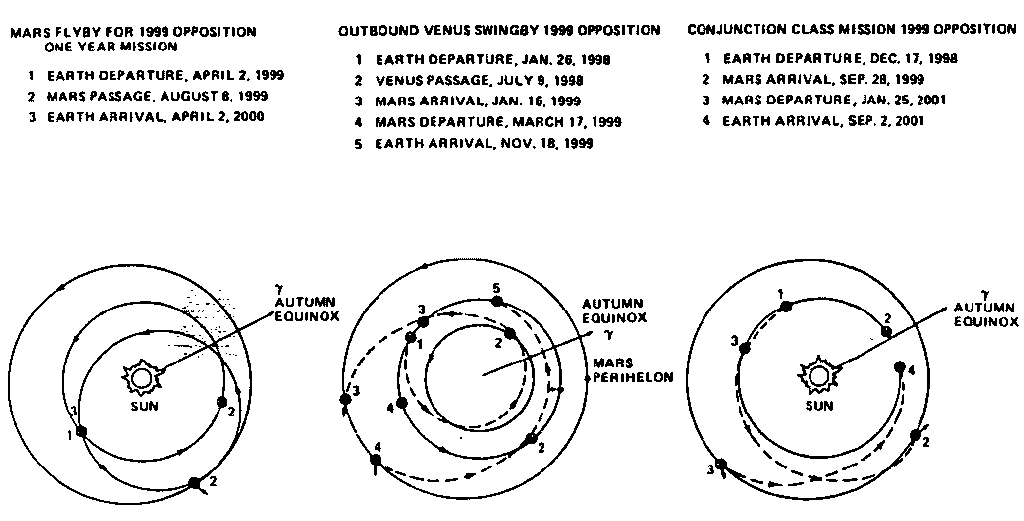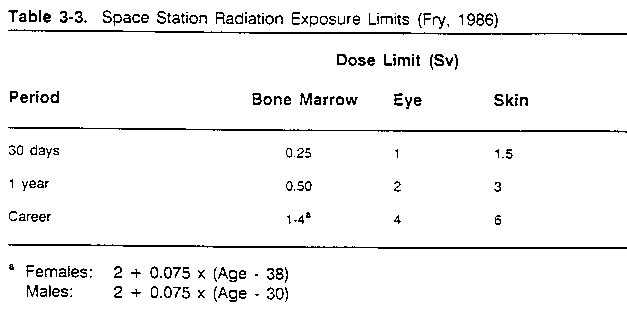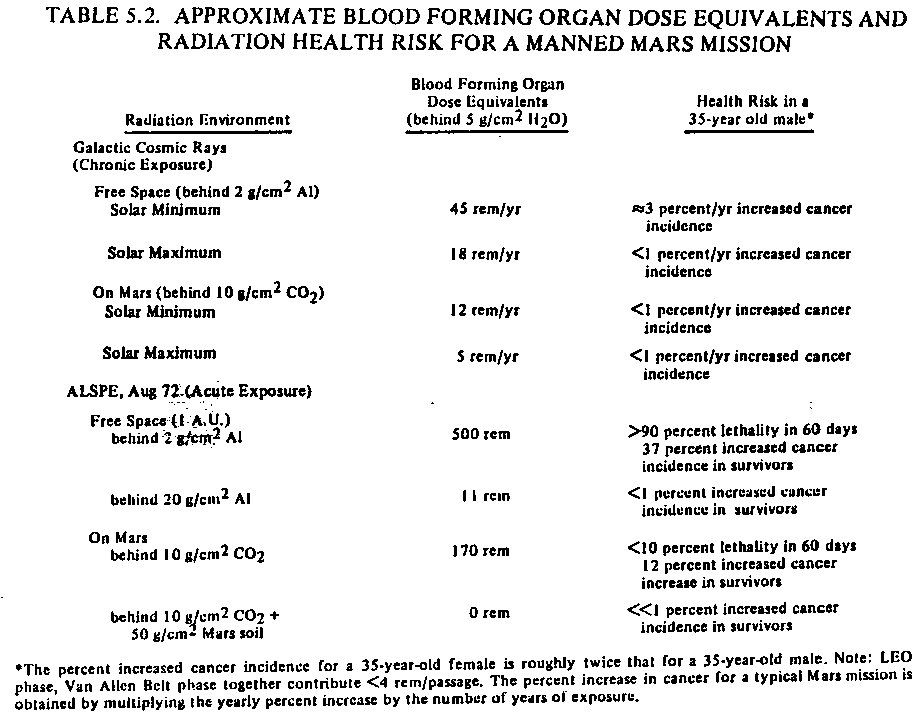NEEP602 Course Notes (Fall 1997)
Resources from Space
Lecture #25: The Martian Chronicles - Reprise!
Title: Mars Base Activation Scenarios
Notes:
 Types of Trajectories to Mars (Duke, et al., 1985)
General Approach
o Split/Sprint-Opposition Class (1988 NASA Office of Exploration)
o Robotic precursors
o One cargo vehicle/one crew vehicle
o 14 months
o 30 days in orbit
o 20 days on surface
o 4 crew on surface/4 in orbit
o 60 total hours of EVAs by 2 crew members
o 3 missions
o Split/Sprint-Opposition Class (1988 NASA JSC)
o Robotic precursors
o One cargo vehicle/one crew vehicle
o 14 months
o 30 days in orbit
o <20 days on surface
o 2 crew on surface/1 in orbit
o 60 total hours of EVAs by 2 crew members
o 1 mission
o Venus swing-by (Collins, 1988)
o Robotic precursors?
o One vehicle
o 22 months
o 30 days in orbit?
o 40 days on surface
o 4 crew on surface/4 in orbit?
o 120 total hours of EVAs by 2 crew members?
o 3 missions?
o Minimum Energy-Conjuction Class (Neal, et al., 1989)
o Reconnaissance from orbit/No robotic precursors required
o One vehicle/two landers
o 32 months
o 18 months in orbit
o 90 total days on surface
o 4 crew on surface/4 in orbit alternating to surface
o 1200 total hours EVAs by 8 crew members at two sites
o 4 missions/8 sites with fifth mission the creation
of a permanent Mars base with 8 initial inhabitants
o "Mars Direct" Conjunction Class (Zubrin, 1996)
Types of Trajectories to Mars (Duke, et al., 1985)
General Approach
o Split/Sprint-Opposition Class (1988 NASA Office of Exploration)
o Robotic precursors
o One cargo vehicle/one crew vehicle
o 14 months
o 30 days in orbit
o 20 days on surface
o 4 crew on surface/4 in orbit
o 60 total hours of EVAs by 2 crew members
o 3 missions
o Split/Sprint-Opposition Class (1988 NASA JSC)
o Robotic precursors
o One cargo vehicle/one crew vehicle
o 14 months
o 30 days in orbit
o <20 days on surface
o 2 crew on surface/1 in orbit
o 60 total hours of EVAs by 2 crew members
o 1 mission
o Venus swing-by (Collins, 1988)
o Robotic precursors?
o One vehicle
o 22 months
o 30 days in orbit?
o 40 days on surface
o 4 crew on surface/4 in orbit?
o 120 total hours of EVAs by 2 crew members?
o 3 missions?
o Minimum Energy-Conjuction Class (Neal, et al., 1989)
o Reconnaissance from orbit/No robotic precursors required
o One vehicle/two landers
o 32 months
o 18 months in orbit
o 90 total days on surface
o 4 crew on surface/4 in orbit alternating to surface
o 1200 total hours EVAs by 8 crew members at two sites
o 4 missions/8 sites with fifth mission the creation
of a permanent Mars base with 8 initial inhabitants
o "Mars Direct" Conjunction Class (Zubrin, 1996)
o One automated crew return vehicle/one delayed crew vehicle
o 30 months
o Manufacture return fuel and oxidizer prior to crew launch
o 0 days in orbit
o 18 months on surface
o 4 crew on surface/0 in orbit
o Repeated missions
o Major possible enhancement options
o Launch from the Moon with lunar derived consumables (greater payload) (see Stancati, et al., 1991)
o 3He propulsion (shortened transit time)
o Trajectory shaping (flexible stay times at Mars)
o Aerobraking (Mars orbit insertion and return to Earth
o Solar electric propulsion during "coast" phases
o Return propellant derived from Mars atmosphere
(Zubrin, et al., 1991, and see Stancati, et al., 1991)
o Other?
Constraints
o Need for flexibility upon arrival in Mars orbit
o Decent delay due to equipment or weather problems
o Surface exploration delay due to equipment, weather,
adaptation, or biological hazard problems
o Ascent delay due to equipment problems
o Early ascent due to degrading systems or a crew health problem
o Need to explore Phobos and/or Deimos
o Need for transit protection against solar particle events
o "Mission control" is in Mars orbit
o Mission monitoring and non-time critical data processing on Earth
o High rate data transmission Mars-Earth-Mars
o Communications relay when sun is between Earth and Mars
o Landing site verifications from Mars orbit sensors and analysis
o In-route simulation and training required for various
mission events
o Other?
Crew Selection
o Skill mix and cross-training
o Experience
o Physical capability
o Medical risk analysis?
o Psychological risk analysis?
o Physiological and psychological tolerance to space environment?
Space Station tour?
o Other?
Orbital reconnaissance
o Overall success not dependent on success of precursors
o Take advantage of conduction class requirement of about
16 months in orbit
o Provides current environmental data and human cognitive analysis
on the spot
o Use Earth data processing and consultation
o Build on Mariner, Viking, Pathfinder, and Mars Surveyor data base and
lunar experience for equipment design and initial mission planning
o More information than available prior to Apollo 11 landing
o Mars environment well characterized
(see text from Neal, et al., 1989, and Pathfinder data Dennis: add link to http://mpfwww.jpl.nasa.gov/ops/science.html)
o Landing site selection and verification and detailed
surface mission planning
o spectral data
o radar data
o surface probes/beacons
o landing trajectory precursors through atmosphere
o data fusion software
o sample return to orbit vs tests after landing?
o refine lander payload
Orbital Mission Control
o Communications delay puts Earth out of "real time" loop
o Lander systems monitoring
o Data processing and Earth relay
o EVA planning assistance
o Phobos/Deimos exploration (see text from Neal, 1989)
First and Second missions (possible four landings)
o General exploration and reconnaissance
o Development of criteria for base selection
o Potential to accelerated decision on base site selection
Third and Fourth missions (possible four landings)
o Examination of candidate base sites
o Use fourth landing to set up consumables plant
o General exploration and reconnaissance
General approach to surface activities during initial exploration
o (see text from Neal, 1989, p20-24)
 EVA Traverse Schematic (Neal, et al., 1989)
EVA Traverse Schematic (Neal, et al., 1989)
 45 Day Mars Exploration Scenario (Neal, et al., 1989)
Key points to exploration strategy
o Long duration (45 days) at each landing site
o Two landers raise probability of at least one landing per mission
o Environment/biological activity tests during Week 1
o Readaptation to gravity field during Weeks 1&2, building up to
full length EVAs by Week 3 (see Schmitt, 1990, p80, for
discussion of space adaptation issues)
o 2 person teams alternate between EVA and EVA support
o Sample analysis after Week 2
o Use automated rover capability to double maximum traverse
distance by leapfrog concept
o Ascent simulations start during Week 6
o Automated rover exploration after ascent, potentially to
next landing site
Base activation conceptually similar to lunar base except:
o Lunar consumables available
o Permanent Mars orbital station or Earth-Moon/Mars "cycler"
may have a role
o Access to needed Mars resources simplified (propellants
from atmosphere and water, oxygen, and hydrogen from ice or clay)
o Crew commitment to settle with start of activation?
o Earth managerial involvement minimal
o Earth scientific, technological, and data processing
cooperation important for the long term
o No anticipated direct economic return
Enroute science
o All missions to Mars and their return, as well as
Earth-Moon/Mars "cyclers" offer the opportunity for
very long base line interferometry
o Sample return legs also can be used for sample analysis
and information transfer to the next mission crew
o Other?
Major issues
o Political, social, philosophical, and/or economic catalyst
o Technological foundations
o Public uneasiness
o Catalytic event or circumstance
o Articulate and committed leadership
o Scientific understanding of human adaptation to
the space environment
o Techniques for "occupational" medical practice
based on that understanding
o Protection in transit from solar particle events
o Minimum energy or accelerated trajectories
o Maximum feasible payloads
o Availability of lunar resources
o Means of financing
o International role in implementation
o Other?
General Aspects of Radiation in Space
45 Day Mars Exploration Scenario (Neal, et al., 1989)
Key points to exploration strategy
o Long duration (45 days) at each landing site
o Two landers raise probability of at least one landing per mission
o Environment/biological activity tests during Week 1
o Readaptation to gravity field during Weeks 1&2, building up to
full length EVAs by Week 3 (see Schmitt, 1990, p80, for
discussion of space adaptation issues)
o 2 person teams alternate between EVA and EVA support
o Sample analysis after Week 2
o Use automated rover capability to double maximum traverse
distance by leapfrog concept
o Ascent simulations start during Week 6
o Automated rover exploration after ascent, potentially to
next landing site
Base activation conceptually similar to lunar base except:
o Lunar consumables available
o Permanent Mars orbital station or Earth-Moon/Mars "cycler"
may have a role
o Access to needed Mars resources simplified (propellants
from atmosphere and water, oxygen, and hydrogen from ice or clay)
o Crew commitment to settle with start of activation?
o Earth managerial involvement minimal
o Earth scientific, technological, and data processing
cooperation important for the long term
o No anticipated direct economic return
Enroute science
o All missions to Mars and their return, as well as
Earth-Moon/Mars "cyclers" offer the opportunity for
very long base line interferometry
o Sample return legs also can be used for sample analysis
and information transfer to the next mission crew
o Other?
Major issues
o Political, social, philosophical, and/or economic catalyst
o Technological foundations
o Public uneasiness
o Catalytic event or circumstance
o Articulate and committed leadership
o Scientific understanding of human adaptation to
the space environment
o Techniques for "occupational" medical practice
based on that understanding
o Protection in transit from solar particle events
o Minimum energy or accelerated trajectories
o Maximum feasible payloads
o Availability of lunar resources
o Means of financing
o International role in implementation
o Other?
General Aspects of Radiation in Space
 Space Station Radiation Exposure Limits (from Neal, et al., 1989, p138)
Sv = Sievert (radiation dosage unit of measure = 100 rem)
Space Station Radiation Exposure Limits (from Neal, et al., 1989, p138)
Sv = Sievert (radiation dosage unit of measure = 100 rem)
 Effective Doses for Acute Radiation Effects (from Neal, et al., 1989, p139)
Gy = Gray (radiation dosage unit of measure = 100 rad)
Effective Doses for Acute Radiation Effects (from Neal, et al., 1989, p139)
Gy = Gray (radiation dosage unit of measure = 100 rad)
 Health Risk for Mars Mission (from Duke, et al., 1985, p68)
Note: "rem" relates absorbed dose to biological
effect and is calculated as the product of
the "absorbed dose" in rads and a "quality factor"
related to the "linear energy transfer" for
ionizing radiation.
Lunar Surface (see Duke, et al., 1985, and text for
Lecture #22, Neal, et al., 1988, Table 2-9)
o Large solar energetic particle events: 10^10 particles/cm2
or greater occur every 7-10 years with a probability at
the Moon of 10-20% each year
o ~250 rem behind 2 gm/cm2 Al and 5 gm/cm2 H2O
o 2-3m lunar soil required to fully shield
o Intermediate events occur 4-6 times/year
o High intensities can last for several days or be repeated
several times in a week
o Galactic cosmic rays doses (1-2.5 particles/cm2/s) will
not exceed dose limits, however, 5-10m of lunar soil
would be required to reduce exposure to terrestrial
levels (Neal, et al., 1988, p116)
o ~22 rem/yr behind 2 gm/cm2 Al and 5 gm/cm2 H2O
o Non-ionizing radiation probably not a threat with
reasonable precautions (see Neal, et al., 1988, p100-105)
Transit to Mars (see Duke, et al., 1985)
o Protection from solar energetic particles and galactic
cosmic rays must be provided by maximizing low mass
(water, fuels, food, etc.) shielding around crew habitation
and should include a "storm cellar" for large events
o Solar particle event: 500 rem behind
2 gm/cm2 Al and 5 gm/cm2 H2O
o 11 rem behind 20 gm/cm2 Al and 5 gm/cm2 H2O
o Galactic cosmic rays: 45 rem/yr behind
2 gm/cm2 Al and 5 gm/cm2 H2O
Mars Surface (see Duke, et al., 1985, and text
from Neal, et al., 1989, p67, Table 2-9)
o Galactic cosmic radiation (90% protons, 9% helium nuclei,
1% heavy ions) about one-half of that on lunar surface due
to atmosphere (10 gm/cm2 CO2)
o 0.5-1.3 particles/cm2/s vs 1-2.5 particles/cm2/s on the Moon
o 12 rem/yr behind 5 g/cm2 H2O
o Solar energetic particle flux greatly attenuated by
atmosphere (10 g/cm2 CO2) and half sphere, but would be
serious for largest events
o 170 rem behind 5 g/cm2 H2O
o Shielding toward zenith with 50 g/cm2 of soil would be
one approach
o Ultraviolet radiation at 190-300 nm, and one-half
the flux at Earth distance, penetrate (rest absorbed by CO2)
but flux is much greater than on Earth's surface
Health Risk for Mars Mission (from Duke, et al., 1985, p68)
Note: "rem" relates absorbed dose to biological
effect and is calculated as the product of
the "absorbed dose" in rads and a "quality factor"
related to the "linear energy transfer" for
ionizing radiation.
Lunar Surface (see Duke, et al., 1985, and text for
Lecture #22, Neal, et al., 1988, Table 2-9)
o Large solar energetic particle events: 10^10 particles/cm2
or greater occur every 7-10 years with a probability at
the Moon of 10-20% each year
o ~250 rem behind 2 gm/cm2 Al and 5 gm/cm2 H2O
o 2-3m lunar soil required to fully shield
o Intermediate events occur 4-6 times/year
o High intensities can last for several days or be repeated
several times in a week
o Galactic cosmic rays doses (1-2.5 particles/cm2/s) will
not exceed dose limits, however, 5-10m of lunar soil
would be required to reduce exposure to terrestrial
levels (Neal, et al., 1988, p116)
o ~22 rem/yr behind 2 gm/cm2 Al and 5 gm/cm2 H2O
o Non-ionizing radiation probably not a threat with
reasonable precautions (see Neal, et al., 1988, p100-105)
Transit to Mars (see Duke, et al., 1985)
o Protection from solar energetic particles and galactic
cosmic rays must be provided by maximizing low mass
(water, fuels, food, etc.) shielding around crew habitation
and should include a "storm cellar" for large events
o Solar particle event: 500 rem behind
2 gm/cm2 Al and 5 gm/cm2 H2O
o 11 rem behind 20 gm/cm2 Al and 5 gm/cm2 H2O
o Galactic cosmic rays: 45 rem/yr behind
2 gm/cm2 Al and 5 gm/cm2 H2O
Mars Surface (see Duke, et al., 1985, and text
from Neal, et al., 1989, p67, Table 2-9)
o Galactic cosmic radiation (90% protons, 9% helium nuclei,
1% heavy ions) about one-half of that on lunar surface due
to atmosphere (10 gm/cm2 CO2)
o 0.5-1.3 particles/cm2/s vs 1-2.5 particles/cm2/s on the Moon
o 12 rem/yr behind 5 g/cm2 H2O
o Solar energetic particle flux greatly attenuated by
atmosphere (10 g/cm2 CO2) and half sphere, but would be
serious for largest events
o 170 rem behind 5 g/cm2 H2O
o Shielding toward zenith with 50 g/cm2 of soil would be
one approach
o Ultraviolet radiation at 190-300 nm, and one-half
the flux at Earth distance, penetrate (rest absorbed by CO2)
but flux is much greater than on Earth's surface
Questions:
1. Discuss the proposal of Zubrin (1991) to produce propellants from the Martian atmosphere and whether or not you would have confidence, considering all other risks, to depend on such propellants on the first mission.
2. During reconnaissance of potential landing sites for the first two Martian landings, what information would you like to gather and in what priority.
3. What would your prime selection criteria be for the site of the first Martian base and why?
Text:
Neal, et al., 1989, pages 1-24 and figure 1-1, pages 45-67,
and
References:
Bradbury, R., 1950, The Martian Chronicles, Doubleday, New York.
Collins, M., 1989, Mission to Mars, National Geographic.
Duke, M.B., and Keaton, P.W, editors, 1985, Manned Mars Missions: A Working Group Report, Marshall Space Flight Center Manned Mars Workshop.
Chicarro, A.F., et al., 1990, Mission to Mars: Report of the Mars Exploration Study Team, ESA SP-1117.
Gould, S.J., 1994, A Plea and a Hope for Martian Paleontology, in Neal, Valerie, editor, Where Next Columbus? The Future of Space Exploration, Oxford University Press, Oxford, 107-128p.
Lovejoy, T.E., 1994, Planning for a New Planet, in Neal, Valerie, editor, Where Next Columbus? The Future of Space Exploration, Oxford University Press, Oxford, 93-106p.
Robinson, K.S., 1993, Trilogy -Red Mars-Green Mars-Blue Mars, Bantum, New York.
Stancati, M.L., et al., 1991, In situ Propellant Production: Alternatives for Mars Exploration, NASA Lewis Research Center Contract NAS3-25809, NASA CR 187192,127p.
Schmitt, H.H., 1990, Something funny may happen on the way to Mars, Aviation, Space, and Environmental Medicine, 61, p79-81.
Zubrin, R.M., and Baker, D.A, 1991, Mars Direct: a simple, Robust, and Cost Effective Architecture for the Space Exploration Initiative, 29th Aerospace Sciences Meeting, January 6-10, 1991, Reno, Nevada..
 |
|
University of Wisconsin Fusion Technology Institute · 439 Engineering Research Building · 1500 Engineering Drive · Madison WI 53706-1609 · Telephone: (608) 263-2352 · Fax: (608) 263-4499 · Email: fti@engr.wisc.edu |
Copyright © 2003 The Board of
Regents of the University of Wisconsin System.
For feedback or accessibility issues, contact
web@fti.neep.wisc.edu.
|